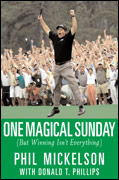One Magical Sunday (But Winning Isn’t Everything)
The New Yorker Magazine is famous for many things, including its cartoons, its covers, and the length of some of its articles.
I thought about this last part of the long-running magazine’s reputation after reading this fast-reading, slender little book, appearing on the bookstore shelves just in time for this spring’s Masters Tournament.
If it were subjected to a word count, I’ll bet the book wouldn’t be too much longer than some New Yorker pieces, such as Roger Angell’s annual baseball reviews.
It’s not just because avid golfers are already familiar with many parts of Phil Mickelson’s life. In part it’s also due to the structure of the book.
Mickelson provides a hole-by-hole description of his final round in the 2004 Masters, where he fulfilled the wishes of thousands of fans and himself by winning his first major golf tournament. The 18-hole story forms the book’s framework.
Interspersed among the how-I-did-it stuff are a series of stories from Phil, his wife Amy, his parents, his siblings, his college golf coach, and others. These short pieces are stitched together to provide an authorized sports biography of a young man whose obsession with golf began early in his life, and shows no sign of abating any time soon.
The book reads almost like a modern documentary film script, complete with quick cuts and flashback segments. The device is useful in helping to explain how Mickelson found himself in contention in this particular Masters, with millions of golf fans pulling for him to finally win one after so many close finishes.
Is it stirring stuff? Sure, if you’re already one of Phil’s fans. If you’re not, though, it’s a bit harder to come to that conclusion.
There is admittedly a certain goofy charm about the boy, despite his past tendency to try out his Hugh Grant-like sheepish grin on far too many occasions.
His golf talent is undeniable, as was Mickelson’s former inclination to go for the high-risk, high-reward shot a few too many times.
Among more neutral observers, the primary reason Mickelson won the 2004 Masters is because he managed to curb his enthusiasm for the nearly-impossible shot in favor of a slightly more conservative approach. The change in playing attitude shaved off just enough bogeys and one-putt pars to produce the desired result.
Is it too much to say that Mickelson finally grew up enough to win the big one? This book gives some hints that it’s nonetheless true, especially in the segments dealing with his wife and children.
The story of how he met the fetching Amy Mickelson and married her provides some nicely humanizing elements to Mickelson’s biography.
For all his talents on the golf course, he was as awkward and immature as most other American males would be in the presence of such a stunning young woman. His faltering attempts at winning over her parents should produce painful winces of self-recognition among some readers.
On the other hand, the troubles that the young couple faced in producing their children were easily the darkest days in what had otherwise been a relatively untroubled, sunny life. These parts of the story perhaps show how Mickelson came to understand golf’s real priority in his life, and give the strongest clues about the sources of Mickelson’s improved maturity.
This isn’t exactly a warts-and-all book, of course–few sports-oriented autobiographies ever are. Readers looking for truly dark stuff about Mickelson will have to look elsewhere.
On the other hand, the book certainly gives its readers a glimpse of how Phil would like to be considered by others.
And if he can continue to live up to the self-described standards he set out in this book, Mickelson should have a great life, no matter what else happens to him in his professional golf career.
Review date: April 9, 2005


